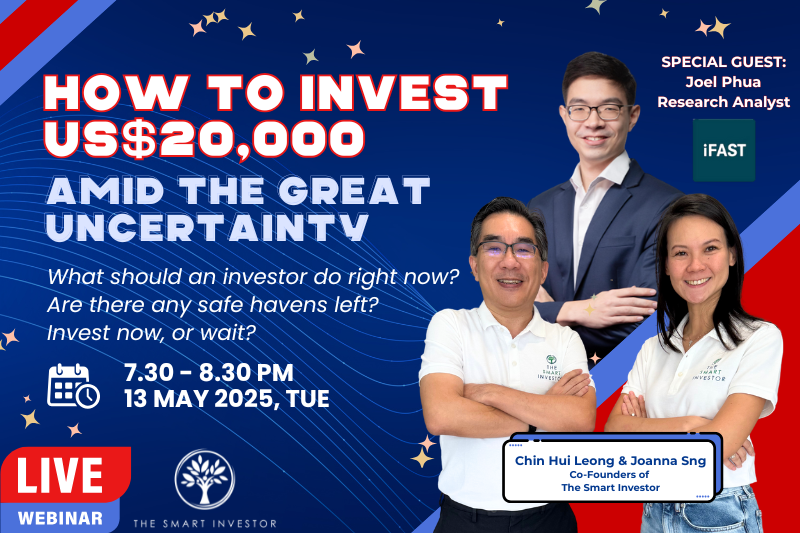Investing may seem daunting when you first start out as it involves a substantial amount of research, reading and due diligence. You may also be confused by the many different kinds of investing styles out there and may struggle to find one that is suitable for yourself.
Truth be told, investing is not as simple as it sounds as it does involve some measure of knowledge on how to interpret financial statements and understand valuations. However, you also need not feel overly discouraged as these skills can be picked up over time with careful study and diligence.
It’s important for you to define your own investing style, as it is something that is intensely personal and should gel with your temperament and psychology. Let’s start off with the two extreme ends of investing – income versus growth.
Income investors rely heavily on companies which pay out consistent and regular dividends in order to supplement their active income or provide them with a passive income source for retirement.
On the other end of the spectrum, growth investors invest in companies that do not pay out a dividend as they are reinvesting their earnings back into the business and growing top and the bottom line quickly.
A continuum, rather than absolutes
In reality, not many investors exist at both extremes but are instead found along a steady continuum combining some aspects of growth versus income.
That is because there are inherent problems with each “pure” strategy – income investors do enjoy a steady passive stream of dividends but their portfolio may remain stagnant over time as the underlying companies show little or no growth.
Growth investors, on the other hand, may see impressive capital gains arising from rapid growth in revenue and earnings but they suffer from a lack of income to supplement their daily expenses.
Moreover, growth investing generally may entail a higher level of risk as high-growth companies usually price in a lot of optimism and expectations, and therefore trade at lofty valuation multiples.
What is ValueGrowth?
A good middle ground which I personally practice is known as the “ValueGrowth” strategy.
This involves a mix of growth plus dividends in order for me to enjoy the “best of both worlds”.
Of course, the devil is in the details as I have to also ask myself how far I am along that continuum separating growth from income investors.
The idea is to be able to enjoy some measure of income in the form of a decent (rather than high) dividend yield while waiting for growth catalysts to play out.
This is, in fact, the essence of the ValueGrowth strategy.
Being paid to wait while the company executes its strategic growth initiatives is a great idea because it also helps to buffer against any downside risks of failure.
Remember that dividends are a return to the investor that is crystallised and realised, while capital gains are generally considered more ephemeral unless the investor manages to sell his shares to lock in the gain.
Of course, there is no free lunch in this world, and I have to accept that the dividend yield obtained from ValueGrowth companies may range from just 2% to 4%, rather than above 5% for pure income investors.
Growth rates for such companies may also be in the mid to high single digits rather than double-digits, and the compounding effect may take somewhat longer as compared to pure growth companies that do not pay out a dividend.
This is the compromise I have to accept as a ValueGrowth investor, and the good news is that such companies usually are conservatively financed and have a great track record as well, thereby reducing my overall risk level in case an economic downturn or sector weakness hits.
Representatives of ValueGrowth companies
ValueGrowth companies are not limited to small and mid-sized companies, but may also be found in larger, established blue-chip companies as well.
One such example of a blue-chip ValueGrowth company that I own is Singapore Exchange Limited (SGX: S68), or SGX. SGX pays a regular quarterly dividend of S$0.075 per share for an annual dividend of S$0.30, providing investors with a dividend yield of around 3.6%.
The group is also displaying strong growth in its derivatives division in terms of both volume and value while increasing its bolt-on investments in beefing up its capabilities in equities, fixed income and derivative contracts. Net profit for fiscal 2019 recently hit an 11-year high, while revenue hit a post-IPO 19-year high.
Risks include competition from other stock exchanges as well as declining equities trading volume, but SGX’s wide breadth of derivatives and its strong market position help to mitigate these factors.
Another clear example of a ValueGrowth blue-chip company in my portfolio is SATS Limited (SGX: S58).
The group has raised its annual dividend for the last five consecutive years to S$0.19 per share in fiscal 2019 for a 3.8% dividend yield, while also displaying long-term growth potential in both airline catering and gateway services.
While SATS has been hit by short-term headwinds related to India’s Jet Airways, the long-term prospects for the group remains promising as the company seeks to consolidate a fragmented airline catering and central kitchen industry in Asia.
The group has also earmarked a total of S$1 billion in investments and capital expenditures over the next three years to strengthen its lead in each market.
Get Smart: Building your ValueGrowth portfolio
A portfolio which contains a good mix of income and ValueGrowth companies ensures the investor gets paid to wait while catalysts play out, while also mitigating the risks from macroeconomic events.
This is a strategy that should be seriously considered by investors as it provides great benefits while lowering the overall risks of the portfolio.
To learn more about the different types of investing strategies, and how you can apply them in your investing journey, sign up for our free investing education newsletter, Get Smart! Click HERE to sign up now.
None of the information in this article can be constituted as financial, investment, or other professional advice. It is only intended to provide education. Speak with a professional before making important decisions about your money, your professional life, or even your personal life.




